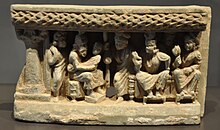Asita
Asita | |
|---|---|
 The prophecy of the seer Asita, slate relief from Gandhara, 3rd/4th century AD (Rietberg Museum, Zurich; Inv. No. RVI 11) | |
| Personal | |
| Religion | Buddhism |
Asita or Kaladevala or Kanhasiri was a hermit ascetic depicted in Buddhist sources as having lived in ancient India. He was a teacher and advisor of Suddhodana, the father of the Buddha, and is best known for having predicted that prince Siddhartha of Kapilavastu would either become a great chakravartin or become a supreme religious leader; Siddhartha was later known as Gautama Buddha.[1]
The name Asita literally means 'not clinging' while Kanhasiri means 'dark splendour'.[citation needed] Asita is described as a tāpasa, a practitioner of asceticism.[2]
Biography[edit]
The Theravada tradition depicts Asita as an advisor and chaplain to Sihahanu, the grandfather of Gotama Buddha.[2] He was the teacher of Suddhodana, and then served him as he had his father.[2] At the time of the birth of the Buddha, he had retired by permission of Suddhodana and was living in the forest as an ascetic.[2]
A vision alerted Asita of the birth of the Bodhisattva Gotama, causing him to leave the forest and travel to see the infant, where he prophesied that he would become either a 'wheel turning monarch' (chakravartin) or a Buddha.[2] Disappointed that his own life would end before the Buddha awakened and began preaching, he ordained his nephew, Nalaka, so that he would be able to hear the Buddha's teachings.[2] Nalaka is called Naradatta in the Lalitavistara.[2]
Names and Related Figures[edit]
Asita was known under several alternate names or nicknames, and Buddhaghosa attributed his name to his dark complexion.[2] He was known as Kanha Devala, Kanha Siri or Siri Kanha, and Kāla Devala.
Another sage or rishi known as Asita Devala is sometimes confused with him in literary sources- this second Asita Devala was a sage from ancient times who was reborn as a disciple of the Buddha.[2] This confusion may explain why in the Lalitavistara Sūtra there are two versions of Asita's prophecy- one where Asita visits Suddhodana as described in the Pali sources, and another where Asita is a hermit living in the Himalayas who never meets Suddhodana but perceives the birth of the Buddha due to his supernatural powers.[2]
The Pali tradition also records a pratyekabuddha called Asita, and a man who lived at the time of Sikkhi Buddha who was reborn as a disciple of Gotama Buddha.[2]
Early Western scholars related Asita to Simeon, who blessed Jesus as an infant.[2]
